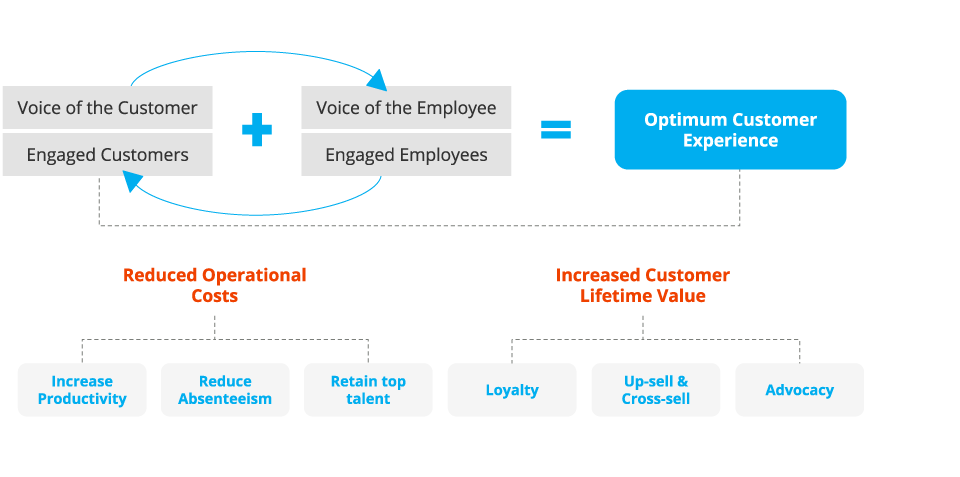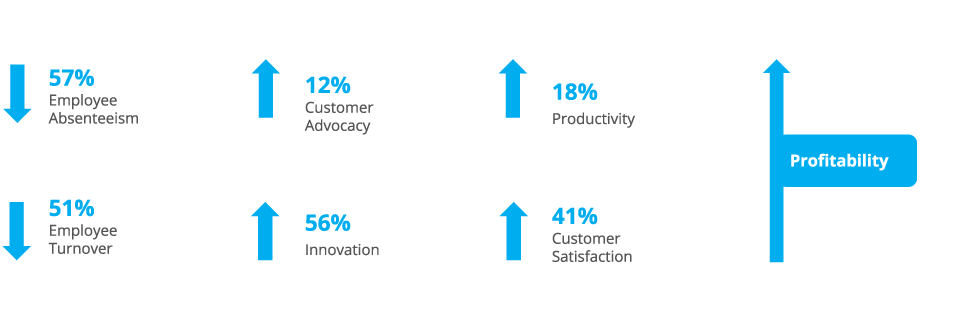 With consumer expectations continuing to rise, businesses have never been more focused on the experiences they're delivering.
With consumer expectations continuing to rise, businesses have never been more focused on the experiences they're delivering.
This is most visible in newer (and more disruptive) businesses piercing through the market, rocking the boat for large corporate businesses built on traditional business models - typically without a focus on CX and quality service.
This shift has led to a surge in CX focused roles, with brands treating customer experience as a priority and a big part of their overall strategy. The trouble is, whilst brands need to ceaselessly create and optimise experiences that matter, they must not forget that customers are only part of the experience equation.
Alignment between customer and employee engagement is imperative if customer experience is to be improved without a negative impact on employees (which in turn damages CX). In this post, we'll dive into the facts, industry research and individual examples of employee engagement success to help you understand the impact on the bottom line.
Let's start by defining the customer/employee engagement relationship and how this translates into a first class customer experience...

An optimum customer experience can be achieved when customers are engaged and the Voice of the Employee is heard within a business. Brands have to do more than just listen to customers and employees, they must ensure their voices are heard across the business. Their voices must reach senior management and feedback must lead to action, it's critical to close the loop with employees and actively demonstrate that their feedback is going to create positive change.
This relationship is a balancing act, from operational changes to culture-led initiatives, businesses must be cautious about anything which could tip the scales either way. This exercise is one of continuous fine-tuning.
The engaged employee
The definition of an engaged employee differs for every business, but really what we're talking about is 'a positive attitude held by the employee towards the organisation and its values'.
An engaged employee is strongly aware of their role and fit within a business, they actively work with colleagues to improve performance for the benefit of the organisation. The organisation must nurture engagement at every opportunity, remembering that this is a two-way relationship between employer and employee.
Source: Institute for Employment Studies
Now is the time to re-think the way you're engaging employees
“A highly engaged workforce can increase innovation, productivity, and bottom-line performance while reducing costs related to hiring and retention in highly competitive talent markets.”
Source: The Impact of Employee Engagement on Performance, HBR
There's now a wealth of documented research and evidence to prove value behind employee engagement and with stats like this, we start to understand the level of focus on employee engagement:
- Only 13% of the global workforce is highly engaged
- 72% of leaders cite employee engagement as their top challenge
- 40% of leaders state not to have an adequate engagement programme
Source: State of the Global Workplace, Gallup, Global Human Capital Trends 2017 Report, Deloitte
The most shocking statistic is that we can see only 13% of the global workforce is highly engaged. This is a problem that's been recognised and we can see the industry is aware of the impact of employee engagement, the question is, how does this translate into business value?
Well, there's also a link between engagement and absenteeism, with Gallup research reporting that an engaged employee takes on average 2.7 sick days per year, whilst a disengaged employee will take 6.2 days.
Businesses can also expect to see an average 40% improvement in turnover when they've nurtured a highly engaged team. This improvement varies from 24% in higher turnover businesses to 59% in lower turnover businesses, covered in the Gallup Q12 Meta-Analysis Report.
From examining research from Deloitte, HBR, Gallup and Engage for Success, we can see that engaged employees have a huge impact on business performance, turnover, customer satisfaction, employee absenteeism and innovation.

SOURCE: Global Human Capital Trends survey, Deloitte. Engage for Success, Harvard Business Review
Research from today's analysts shows us that employee engagement does more than just help a business deliver an exceptional customer experience. It has a huge impact on every area of a business, from bottom line figures to an increase in productivity. With compelling evidence like this, it's easy to understand why brands are focusing on building a great culture and driving engagement.
So, what's next? We know that businesses are focusing on employee engagement, we know why they're doing it and we also know what impact it has. Even with all of this information, CX professionals and senior executives can still have their doubts, they have the research but they need more. If that's you, then you're probably wondering how this can be linked back to hard metrics and value, essentially how can you calculate the ROI behind employee engagement?
Calculating employee engagement ROI
There are a variety of ways to calculate ROI and every business will have their own way. As we know, each and every business operate on different metrics, they track them differently and have their very own business models. You need to do what's right for you, just make sure the data you're collating is accurate.
We're going to cover an interesting example of how you might go about it published by 15five.com, it's a great high-level break down of what you'll need to get a ballpark figure, the data you'll need to hand is:
- Number of employees (at the beginning of the year)
- Number of employees (at the end of the year)
- Average employee salary
- Annual company revenue
- Number of employees that leave during the year
From using these stats you will then be able to work out your employee cost data, please bare in mind that revenue which is made up of these 7 things:
Revenue per employee (sales per employee) - This is all about understanding the financial ratio that measures revenue generated by each employee on average. To work this out, divide the annual company revenue by the average number of employees.
Cost of absenteeism per employee - This is calculated by working out the percentage of total working days that are unearned paid time off. You can use this calculator here from Engage and Prosper as a benchmark. To perform this example, we'll take the percentage as being 1.2%. To calculate this, simply take 1.2% of revenue per employee and add that to 1.2% of the average employee salary.
Total cost of absenteeism - Total up the cost of absenteeism per employee x the amount of employees at your business.
Turnover rate - Calculate this by dividing the number of employees that left during the year by the average number of employees during the year.
Number of employees that leave in a year - This is the turnover rate multiplied by the average number of employees.
Average cost to replace an employee - This will be different for each and every business and you'll likely find research that varies. However, a common consensus comes from The Society for Human Resources Management (SHRM), stating that every time that a business replaces an employee, it costs between 6-9 months of the replaced employee's salary. This doesn't include other factors such as training costs, culture impact and other implications as the result of replacing an employee.
Total cost of employee turnover - To work this out you'll need to multiply the average cost to replace an employee by the number of employees that resigned last year.
You can now work out your total return on investment value by forecasting what improvements employee engagement will make. The best way to do this is to take the amount of revenue added due to a % increase in employee productivity. Plus the money saved from a % reduction in absenteeism and a % decrease in turnover.
As we've discussed, having the facts and figures to hand is the first step in identifying the impact of employee engagement, but it's also critical if you're putting a business case together. The second step is all about having your own way to calculate the ROI for employee engagement, this will require some finessing however it's having a base to start from that matters. The next step now is to bring all of these proof points together and show the board what kind of impact an employee engagement initiative can have.
Conclusion
If your business is serious about crafting an exceptional customer experience, then you'll already have strong customer representation in the boardroom. Pitching in the importance of employee engagement will be less of a struggle in organisations that are already customer focused - the link between both is strong. However, as we know all too well, the real struggle behind any customer or employee engagement programme is linking up the data to show the return on investment for the business. We hope that the ideas, research and methods we've discussed will help you on your mission to drive brilliant engagement through your organisation.
We'll now close off with the key takeaways, giving you a high-level view of just what kind of impact true engagement can create.
In summary, brands and businesses can expect to see these benefits:
- The ability to identify problems early and understand them deeper. For example, a particular issue the customer is experiencing may be due to a problem escalating within a department. The ability to link the impact of these issues allows a business to understand it's intricacies.
- The ability to establish a pulse check on the business, allowing CX professionals and senior executives to keep track of the internal 'health' of the business.
- Higher staff retention and the ability to attract more talent. It's commonplace for job seekers to do an audit of the businesses they're considering for employment. For example, Glassdoor popularity continues to soar with more and more job seekers using it to benchmark companies against each other.
- Increased wellbeing across the business, improving productivity and cross-departmental and interdepartmental relationships. When people are happier, they're much more likely to engage in co-operation and bond together as a team working towards business goals.
- A reduction in employee absenteeism. This is a huge metric for any business that's looking to perform at an optimum level every quarter. When employees actively avoid work due to stress, poor management, bad relationships, the business suffers a direct impact on the bottom line.
- The creation and amplification of brand advocates. Wherever true employee engagement exists, you'll find employees who are passionate about their purpose, organisation and role. It's essential to hold on to these employees, their positivity is infectious which is key for building strong relationships with customers and prospects.
- A reduction in recruitment costs. A business with a high turnover of employees also suffers from an unseen financial burden. When an employee leaves for the wrong reasons, it's the responsibility of the business to understand why this happened. This is why capturing the Voice of the Employee is so important. Sometimes, employees do leave for the right reasons, but when this happens it's essential that businesses build strong handover processes and minimise negative business impact.



